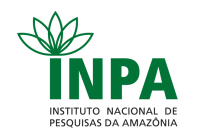Corpo Discente - Egressos
Grace Rente dos Santos
| Título | USO DOS RECURSOS NATURAIS DAS COMUNIDADES DO POLO 3 DA RESERVA DE DESENVOLVIMENTO SUSTENTÁVEL UATUMÃ - AMAZONAS - BRASIL | ||||||||||||||||||||||||
| Data da Defesa | 27/02/2024 | ||||||||||||||||||||||||
| Download | Visualizar a Tese(2.09MB) | ||||||||||||||||||||||||
Banca
| |||||||||||||||||||||||||
| Palavras-Chaves | Uatumã; Comunidades ribeirinhas; Sistema agroflorestal; Quintais rurais; Região Amazônica | ||||||||||||||||||||||||
| Resumo | É provável que a utilização das plantas como medicamento seja tão antiga como o próprio homem. A relação do homem com a natureza é complexa e surge a partir da dinâmica que envolve as suas ações que modificam o meio no qual está inserido. Ainda que a natureza realize sua própria transformação, o homem é o principal responsável pelas maiores alterações na natureza ao longo dos tempos. A construção dos dados que embasou as análises se pautou na observação participante e entrevistas semiestruturadas realizadas in loco nos espaços junto aos moradores. Neste contexto, esta Tese de doutorado teve como objetivo principal identificar a influência da condição socioeconômica dos ribeirinhos em relação às múltiplas formas da terra e a forma que utilizam os recursos naturais ao seu redor. Esta pesquisa foi realizada durante a primeira visita no período de 20 a 27 de janeiro de 2020 e na segunda visita, durante o período de 18 a 26 de outubro 2020 entre as comunidades Bela Vista, Maracarana, São Benedito e Manain. Foram realizadas um total de 58 entrevistas com representantes de famílias ribeirinhas das comunidades. Os principais resultados apontam que o total de entrevistados nas quatro comunidades pesquisadas, 61,8% foram do sexo masculino com expressiva maioria nas comunidades de Bela Vista e Manain, enquanto, 28,2% do total são do sexo feminino, predominante na comunidade de Maracarana. De forma geral, um total de 38,2% famílias residem há mais de 20 anos em suas terras, enquanto na outra extremidade (34,6%) têm até 10 anos. Entre os entraves relatados estão relacionados à rede de distribuição de energia (69,1%) e com a dificuldade com transporte (30,9%). Verificou-se nos quintais que 75,9% dos entrevistados afirmam ter mais roçado, enquanto e 24,1% afirmam possuir mais floresta e somente um entrevistado não soube dizer se tem mais roçado ou mais floresta. Em relação à caracterização, a maioria dos quintais agroflorestais avaliados situam-se aos fundos das moradias (80%), poucos estavam ao lado (7%) ou na frente das mesmas (13%). No levantamento botânico as famílias mais representativas em número de espécies foram Fabaceae com 8 espécies, o que representa 13,6 % do número total de espécies, seguida de Lamiaceae com 5 espécies (8,5 %), Araceae e Rutaceae com 3 espécies cada, representando uma porcentagem de 5,1 cada família. O uso de mandioca/macaxeira (Manihot esculenta Crantz), foi mencionado por todos os informantes. Ao total está planta foi citada 132 vezes o que representa 31,88 % do total de citações, sendo que mandioca foi citada 115 vezes e macaxeira 17. Esse alto número de citações reflete a importância dessa espécie tanto na alimentação quanto no sustento da família dos entrevistados, uma vez que vii 81,7% dos comunitários citaram a farinha de mandioca como o alimento mais produzido nas comunidades. O estudo mostra que existe uma dependência das plantas nativas pelos moradores, o fato de as comunidades estarem logisticamente distante dos centros urbanos, faz com que a interação entre as comunidades seja mais próxima do que com as cidades próximas | ||||||||||||||||||||||||
| Abstract | It is likely that the use of plants as medicine is as old as man himself. Man`s relationship with nature is complex and arises from the dynamics that involve his actions that modify the environment in which he is inserted. Although nature carries out its own transformation, man is primarily responsible for the greatest changes in nature over time. The construction of the data on which the analyzes were based was based on participant observation and semi-structured interviews carried out in loco in the spaces with the residents. In this context, this doctoral thesis had as its main objective to identify the influence of the socioeconomic condition of riverside dwellers in relation to the multiple forms of the land and the way they use the natural resources around them. This research was carried out during the first visit in the period from January 20 to 27, 2020 and in the second visit, during the period from October 18 to 26, 2020 between the communities Bela Vista, Maracarana, São Benedito and Manain. A total of 58 interviews were carried out with representatives of riverside families in the communities. The main results indicate that the total number of respondents in the four communities surveyed, 61.8% were male, with a significant majority in the communities of Bela Vista and Manain, while 28.2% of the total are female, predominantly in the community of Maracarana. In general, a total of 38.2% families have lived on their land for more than 20 years, while at the other end (34.6%) they have lived on their land for up to 10 years. Among the obstacles reported are related to the energy distribution network (69.1%) and the difficulty with transportation (30.9%). It was found in the backyards that 75.9% of respondents claim to have more clearings, while 24.1% claim to have more forest and only one interviewee could not say whether there is more clearing or more forest. Regarding characterization, most of the evaluated agroforestry backyards are located at the back of the houses (80%), few were next to them (7%) or in front of them (13%). In the botanical survey the most representative families in number of species were Fabaceae with 8 species, which represents 13.6% of the total number of species, followed by Lamiaceae with 5 species (8.5%), Araceae and Rutaceae with 3 species each, representing a percentage of 5.1 each family. The use of cassava/cassava (Manihot esculenta Crantz) was mentioned by all informants. In total, this plant was cited 132 times, which represents 31.88% of the total of citations, with cassava 115 times cited and cassava 17 times. This high number of citations reflects the importance of this species both in food and in the livelihood of the family of interviewed, since 81.7% of the community ix mentioned cassava flour as the most produced food in the communities. The study shows that there is a dependence on native plants by residents, the fact that communities are logistically distant from urban centers, makes the interaction between communities closer than with nearby cities | ||||||||||||||||||||||||
Parceiros

























